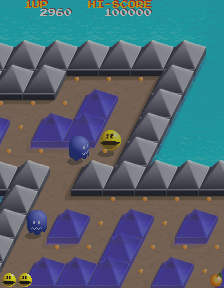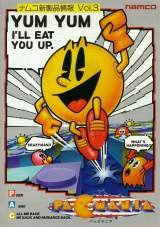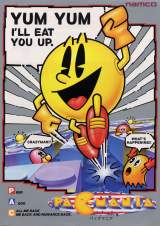
Pac-Mania © 1987 Namco, Limited.
Pac-Mania is a maze-based game in which players maneuver Pac-Man through a world of isometric 3-D mazes. As with previous games in the series, the objective is to eat all of the pellets and power pills in the mazes while avoiding the pursuing ghosts. Pac-Man can now bounce, allowing him to jump over ghosts to avoid being caught.
At the start of a game players are given the opportunity to choose which of three worlds they wish to tackle first: Block Town, Pac-Man's Park or Sandbox Land. Block Town is the easiest of the three and Sandbox Land is the hardest, with more points earned for completing a harder world.
Each maze contains four power-pills that make Pac-Man temporarily invincible, during this time the ghosts turn blue and can be eaten. These 'Skinned' ghosts, now visible as a pair of eyes only, will then return to their den in the middle of the maze, regenerate into their former selves, and return to the maze to continue their pursuit.
During play, bonus food items or a red or green power-pill regularly appears in the middle of the maze (accompanied by a sound alerting players to its presence), these items only appear for a few seconds. The green pill gives Pac-Man extra speed while the red pill awards double points. The green pill lasts until either a life is lost, another power-pill is eaten, or until the end of the round. The red pill lasts until either a life is lost or until the end of the round
The ghosts include the returning Blinky, Pinky, Inky and Clyde from the original Pac-Man, as well as Sue (from "Ms. Pac-Man" and "Pac-Land") who has changed colour from orange to purple. She now homes in on Pac-Man's location and will follow him around. There is also a new ghost called Funky who, like Pac-Man, can also bounce.
An optional continue feature is offered to allow players to continue their progress without having to start back at the beginning. Bonus points are awarded once certain points thresholds have been reached and are adjustable in the game's dip settings.

Namco System 1 hardware
Game ID : PN
Main CPU : 6809 (@ 1.536 Mhz)
Sub CPU : 6809 (@ 1.536 Mhz)
Sound CPU : 6809 (@ 1.536 Mhz)
MCU: HD63701 (@ 1.536 Mhz)
Sound Chips : Yamaha YM2151 (@ 3.57958 Mhz), Namco advanced 8-channel stereo WSG, stereo DAC
Screen orientation : Vertical
Video resolution : 224 x 288 pixels
Screen refresh : 60.61 Hz
Palette colors : 24-bit RGB palette
Players : 2
Control : 4-way joystick
Buttons : 1 (BOUNCE)
Pac-Mania was released in November 1987 in Japan.
After the superb platform action of the series' previous game, "Pac-Land", Namco chose to return the series to its roots with the re-introduction of the 'eat all of the pills in the maze' gameplay of the earlier classics. Pac-Mania feels somewhat different to its illustrious predecessors, however, due to Pac-Man's newly-acquired 'jump' ability. The mazes are now rendered with an isometric, pseudo 3-D viewpoint, allowing the player to jump over the chasing ghosts and make an escape.
The 'Pac-Man's Park' maze is basically the original "Pac-Man" maze in an isometric 3-D perspective.
Another new feature in this game is the appearance of several 'special items' (in addition to the traditional fruit bonuses - cherries, strawberries, oranges, apples, bananas, apricots, bells, and keys). These items include candy, hamburgers, ice cream cones, coffee, and two special kinds of power pills. The pills, which appear in addition to the traditional power pills, give Pac-Man more points for eating ghosts and also give him extra speed, both of which come in very handy during gameplay.
After Pac-Mania, Pac-Man's next two arcade outings would both come in 1996 with "Pac-Man Arrangement" (part of "Namco Classics Collection Vol.2") and the extrmemely rare "Pac-Man VR". After that, he would have one more arcade outing in 2010 with "Pac-Man Battle Royale".
Donn Nauert holds the official record for this game with 385,570 points.
Victor Entertainment released a limited-edition soundtrack album for this game (Namco Video Game Graffiti Vol.4 - VDR-5282) on March 8, 1989.
The theme music for Pac-Man's Park was remixed for the animated series 'Pac-Man and The Ghostly Adventures' ('Pac-World' in Japan).

| Dot | 60 points |
| Power pill (energizer) | 300 points |
| Red pill (special energizer) | 7,650 points (doubles ghost values up to 7,650) |
| Green pill (speed up) | 1,000 points |
| Ghosts | 200, 400, 800, 1,600, 3,200, and 7,650 points |
| Cherry | 1,000 points |
| Strawberry | 2,000 points |
| Peach | 3,000 points |
| Apple | 4,000 points |
| Banana | 5,000 points |
| Flower | 6,000 points |
| Bell | 7,000 points |
| Key | 8,000 points |
| Candy | 4,000 points |
| Green apple | 6,000 points |
| Coffee cup | 5,000 points |
| Small ice cream cone | 6,000 points |
| Large ice cream cone | 8,000 points |
| Silver bell | 9,000 points |
| Galaxian | 7,650 points |
| Silver key | 10,000 points |
| Hamburger | 7,000 points |
| Silver Galaxian | 7,650 points |
* On the first couple of stages where power pills last long, try to get three or four ghosts near a power pill. Once they are there, it is possible to eat all of the ghost on the board. You'll also rack up lots of points this way after eating the pink pill.
* On later stages, try clearing the pellets on top of the maze first. Not all of the ghost will come out at once, once the level starts.
* On later stages, power pills won't last long. Use those to distract the ghost as you clear the board.
* Jumping is very important. You can jump at least three ghost lengths.
* When a ghost is on your tail, a good way to lose him is to turn around and jump over the ghost.
1. Pac-Man (1980, ARC)
2. Ms. Pac-Man (1981, ARC)
3. Super Pac-Man (1982, ARC)
4. Pac-Man Plus (1982, ARC)
5. Jr. Pac-Man (1983, ARC)
6. Professor Pac-Man (1983, ARC)
7. Pac-Land (1984, ARC)
8. Pac-Mania (1987, ARC)
9. Pac-Attack (1993, SNES, Genesis; 1994, Game Boy, Game Gear)
10. Pac-Man 2 - The New Adventures [Model SNS-25-USA] (1994, SNES, Genesis)
11. Pac-In-Time [Model SNS-APTE-USA] (1994, SNES, PC)
12. Pac-Man Arrangement (1996, ARC) : part of "Namco Classics Collection Vol.2"
13. Pac-Man VR (1996, ARC)
14. Pac-Man World [Model SLUS-00439] (1999, PS)
15. Pac-Man - Adventures in Time (2000, PC)
16. Ms. Pac-Man - Maze Madness [Model SLUS-01018] (2000, PS)
17. Ms. Pac-Man - Quest for the Golden Maze (2001, PC)
18. Pac-Man All-Stars (2002, PC)
19. Pac-Man Fever [Model SLUS-20197] (2002, PS)
20. Pac-Man World 2 [Model SLUS-20224] (2002, PS2, GC, XBOX)
21. Pac-Man Vs. [Model DOL-PRJE-USA] (2003, GC)
22. Pac-Pix [Model NTR-APCE-USA] (2005, DS)
23. Pac-Man Pinball Advance [Model AGB-BP8E-USA] (2005, GBA)
24. Pac-Man Arrangement (2005, PSP) : part of "Namco Museum Battle Collection [Model ULUS-10035]"
25. Pac'n Roll [Model NTR-APNE-USA] (2005, DS)
26. Pac-Man World 3 [Model SLUS-21219] (2005, PSP, PS2, GC, XBOX, PC, DS)
27. Pac-Man World Rally [Model SLUS-21328] (2006, GameCube, PS2, PSP, PC)
28. Pac-Man Championship Edition (2007, XBLA)
29. Pac-Man Championship Edition DX (2010, XBLA, PSN)
30. Pac-Man Party [Model RVL-SP7E-USA] (2010, Wii)
31. Pac-Man Battle Royale (2011, ARC)
32. Pac-Man Tilt (2011, 3DS) : part of "Pac-Man & Galaga Dimensions [Model CTR-APGE-USA]"
33. Pac-Man Championship Edition DX+ (2013, XBLA, PSN, Steam)
34. Pac-Man Dash! (2013, Android/iOS)
35. Pac-Man and the Ghostly Adventures (2013, 3DS, XBOX 360, PS3, Wii U, PC)
36. Pac-Man and the Ghostly Adventures 2 (2014, 3DS, XBOX 360, PS3, Wii U, PC)
Game Design : St. Daimyojin
Character Design : T. Yamashita
Graphic Design : A. Usukusa
Visual Design : Satoshi S., Babe. Teshima, Yukari M., Kazuya G., Tomoyuki S.
Music and Sound : Junko Ozawa, Yuri., Y. Tomuro
Game Program : Taro. Shimizu
System Program : Taro. Shimizu, Kosei M., Dr. Tam., H. Yamazaki
System Design : T. Ogawa, T. Okada, Makoto Inoue, Dr. Tam.
Director : St. Daimyojin, T. Iwatani
Presenter : Fun First Pro., Namco Limited
NOTE: For ports released in North America, please see the Atari version entry.
CONSOLES:
Sega Master System (1991) "Pac-Mania [Model 25010]"
Sega Mega Drive (1991) by Tengen
Sony PlayStation (feb.28, 1997) "Namco Museum Vol.5 [Model SLPS-00705]"
Sony PlayStation (1998) "Namco Museum Vol.5"
Sony PlayStation (feb.1998) "Namco Museum Vol.5 [Model SCES-00702]"
Sony PS2 (jan.26, 2006) "Namco Museum Arcade Hits! [Model SLPS-25590]"
Microsoft XBOX (mar.24, 2006) "Namco Museum - 50th Anniversary"
Sony PS2 (mar.31, 2006) "Namco Museum - 50th Anniversary [Model SLES-53957]"
Nintendo GameCube (may.5, 2006) "Namco Museum 50th Anniversary [Model DOL-G5NP-EUR]"
Nintendo Wii (dec.6, 2007) "Minna de Asobou! Namco Carnival" [Model RVL-RNWJ-JPN]"
Nintendo Wii (apr.18, 2008) "Namco Museum Remix [Model RVL-RN2P]"
 Nintendo Wii (apr.26, 2008) "Namco Museum Remix"
Nintendo Wii (apr.26, 2008) "Namco Museum Remix"
Nintendo Wii (may.1, 2008) "Namco Museum Remix [Model RVL-RN2P]"
Microsoft XBOX 360 (may.15, 2009) "Namco Museum - Virtual Arcade"
Microsoft XBOX 360 (june.3, 2009) "Namco Museum - Virtual Arcade"
 Zeebo (june.16, 2009)
Zeebo (june.16, 2009)
Nintendo Wii [Virtual Console Arcade] (aug.4, 2009)
Microsoft XBOX 360 (nov.5, 2009) "Namco Museum - Virtual Arcade [Model 2RD-00001]"
[MX] Zeebo (nov.4, 2010)
HANDHELDS:
Nintendo GBA (dec.7, 2001) "Pac-Man Collection [Model AGB-P-APCP]"
Nintendo GBA (jan.11, 2002) "Pac-Man Collection [Model AGB-P-APCJ]"
COMPUTERS:
Sinclair ZX Spectrum (1988) by Grandslam
Atari ST (1988) by Grandslam
Amstrad CPC (1988) by Grandslam
Commodore C64 (1988) by Grandslam
MSX (1989)
Sharp X68000 (mar.18, 1989)
Acorn Archimedes (1991)
Commodore Amiga (1992)
PC [MS Windows, CD-ROM] (mar.27, 2006) "Namco Museum - 50th Anniversary"
PC [MS Windows, CD-ROM] (may.19, 2006) "Namco Museum - 50th Anniversary"
Game's ROM.
Machine's picture.